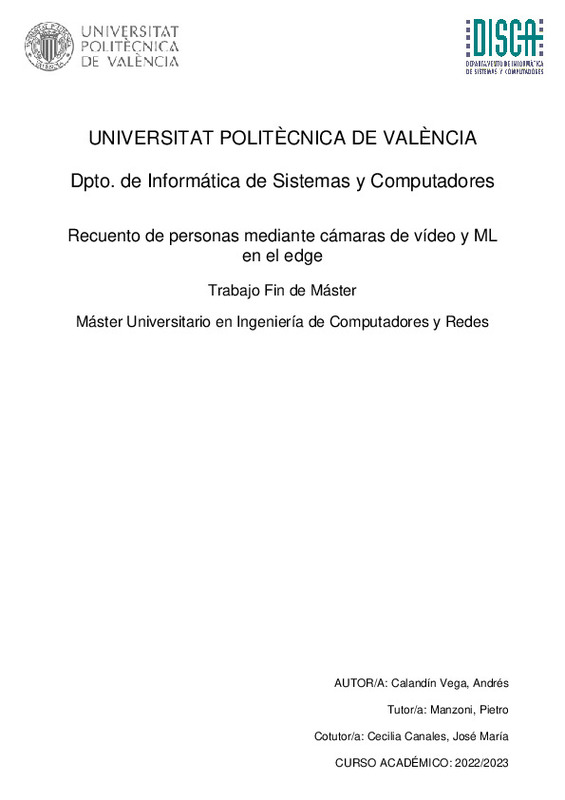JavaScript is disabled for your browser. Some features of this site may not work without it.
Buscar en RiuNet
Listar
Mi cuenta
Estadísticas
Ayuda RiuNet
Admin. UPV
Recuento de personas mediante cámaras de vídeo y ML en el edge
Mostrar el registro sencillo del ítem
Ficheros en el ítem
| dc.contributor.advisor | Manzoni, Pietro
|
es_ES |
| dc.contributor.advisor | Cecilia Canales, José María
|
es_ES |
| dc.contributor.author | Calandín Vega, Andrés
|
es_ES |
| dc.date.accessioned | 2023-11-03T10:43:08Z | |
| dc.date.available | 2023-11-03T10:43:08Z | |
| dc.date.created | 2023-09-27 | |
| dc.date.issued | 2023-11-03 | es_ES |
| dc.identifier.uri | http://hdl.handle.net/10251/199177 | |
| dc.description.abstract | [ES] En los últimos años, el empleo de dispositivos inteligentes ha aumentado drásticamente. Hasta ahora el análisis de los datos recabados los dispositivos se realizaba en un servidor en la nube con alta disponibilidad y capacidad. Este crecimiento ha ocasionado que el tráfico de datos hacia estos servidores se sature, generando retrasos y pérdidas, y por tanto, perjudicando a las aplicaciones que requieran de respuesta en tiempo real. La solución a esta problemática se ha dado en forma del Edge Computing y el TinyML, que proponen que los datos sean analizados en el propio dispositivo, normalmente restringido en capacidad. En este marco, el área del Machine Learning más problemática es la del análisis de imágenes, dada la enorme cantidad de operaciones y tamaño necesarias de las redes neuronales dedicadas a esta tarea. El presente trabajo emplea análisis de imágenes con TinyML en una cámara cómo dispositivo restringido, con el objetivo de identificar las personas que transiten por delante de la cámara e identificar su dirección para definir las personas salientes o entrantes a un espacio concreto. Para lograr esto se emplean modificaciones de redes neuronales convolucionales como YOLO en orden de cumplir los requisitos de memoria y almacenamiento del dispositivo sensor. | es_ES |
| dc.description.abstract | [EN] n recent years, the use of smart devices has increased dramatically. Until now, the analysis of the data collected by the devices was performed on a cloud server with high availability and capacity. This growth has caused data traffic to these servers to become saturated, generating delays and losses, and therefore harming applications that require real-time response. The solution to this problem has come in the form of Edge Computing and TinyML, which propose that data be analyzed on the device itself, normally restricted in capacity. In this framework, the most problematic area of Machine Learning is that of image analysis, given the enormous number of operations and size required of the neural net- works dedicated to this task. The present work uses image analysis with TinyML on a camera as a constrained device, with the objective of identifying people passing in front of the camera and identifying their direction in order to define people leaving or entering a specific space. To achieve this, modifications of convolutional neural networks such as YOLO are used in order to meet the memory and storage requirements of the sensor device | es_ES |
| dc.format.extent | 41 | es_ES |
| dc.language | Español | es_ES |
| dc.publisher | Universitat Politècnica de València | es_ES |
| dc.rights | Reserva de todos los derechos | es_ES |
| dc.subject | Internet of Things (IoT) | es_ES |
| dc.subject | Análisis de imágenes | es_ES |
| dc.subject | Segmentación de imágenes | es_ES |
| dc.subject | Imagen digital | es_ES |
| dc.subject | TinyML | es_ES |
| dc.subject | Seguimiento | es_ES |
| dc.subject | Detección de personas | es_ES |
| dc.subject | Internet de las cosas | es_ES |
| dc.subject | Edge Computing (EC) | es_ES |
| dc.subject.classification | ARQUITECTURA Y TECNOLOGIA DE COMPUTADORES | es_ES |
| dc.subject.other | Máster Universitario en Ingeniería de Computadores y Redes-Màster Universitari en Enginyeria de Computadors i Xarxes | es_ES |
| dc.title | Recuento de personas mediante cámaras de vídeo y ML en el edge | es_ES |
| dc.title.alternative | Person counting using video cameras and ML at the edge | es_ES |
| dc.title.alternative | Recompte de persones mitjançant càmeres de vídeo i ML en el edge | es_ES |
| dc.type | Tesis de máster | es_ES |
| dc.rights.accessRights | Abierto | es_ES |
| dc.contributor.affiliation | Universitat Politècnica de València. Departamento de Informática de Sistemas y Computadores - Departament d'Informàtica de Sistemes i Computadors | es_ES |
| dc.description.bibliographicCitation | Calandín Vega, A. (2023). Recuento de personas mediante cámaras de vídeo y ML en el edge. Universitat Politècnica de València. http://hdl.handle.net/10251/199177 | es_ES |
| dc.description.accrualMethod | TFGM | es_ES |
| dc.relation.pasarela | TFGM\154899 | es_ES |






